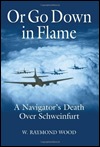 Title: Or Go Down in Flame: A Navigator’s Death Over Schweinfurt
Title: Or Go Down in Flame: A Navigator’s Death Over Schweinfurt
Author: W. Raymond Wood
Format: Hardcover
Published: 2013
My Rating: ![]()
![]()
![]()
![]()
On October 14, 1943, otherwise known as “Black Thursday” to the United States Eighth Air Force, nearly 300 bombers set out on a mission to destroy the ball-bearing industry in Schweinfurt, Germany. This second air battle at Schweinfurt resulted in great loss for the Eighth Air Force, but in hindsight, it can be seen as an important turning point for the air war over Germany.
The main motivation for this book was to tell the story of Black Thursday, the day on which the author lost his brother 2nd Lt. Elbert S. Wood. Although the author was just a boy during World War II, he sought answers about his brother’s service and death. Over the course of many years, his research in records and first-hand accounts from crewman, German civilians, and enemy fighters allowed him to recount the events of that day.
The book is a little broader in scope, however, in that the author chronicles the air war over Germany from start to finish. He also provides details of Lt. Wood’s training and first through sixth missions. Wood’s seventh mission, Second Schweinfurt, would be his last.
The Wicked WAAC was one of the sixty bombers that was shot down on Black Thursday. This B-17, part of the 306th Bomb Group, was under attack shortly after it entered German airspace. Near Frankfurt, the bomber received a “crippling blow” from “a rocket burst that destroyed much of the vertical stabilizer.” Wood sustained shrapnel injuries and eventually bailed near Michelbach, where his body was found and buried. With continuing chaos on board, the remaining men bailed at various points before the B-17 crashed outside of Geiselbach. Through the author’s research, he was able to determine the fate of his brother, along with the other crewmen aboard the Wicked WAAC.
The author cleverly pieces his research together to provide the reader with a feeling they are there, right alongside these brave men. As a reader, you become invested in Lt. Wood and his fellow airmen; you smile with them through the good times and shed a tear for them through the devastation.
Rounding out the narrative portion of this book is a discussion of the American Graves Registration Command, which was “to be responsible for the location, identification, and interment of the remains of American military personnel who fell in World War II. (Note: Prior to the establishment of AGRC in 1945, the Graves Registration Service, from World War I, was reinstituted in 1942 to perform this work.) Not only does the author describe the work of this unit, he shares the process of his brother’s identification and his ultimate return home for burial in the states.
Those who have in interest in air combat, World War II, and military history in general will likely enjoy this book. The details in this book paint a picture of what the air war over Germany was like, on the good days and the bad. Those with kin who served in World War II might find insight into their relative’s experience in this book, particularly because veterans don’t tend to talk about their service or are no longer around to do so. Anyone who is interested in researching World War II servicemen, especially those lost overseas, will get ideas for further inquiry not only by reading the narrative, but also in the appendix and the references and sources portion of the book.
Overall, this book is a fitting tribute to Lt. Woods, the Wicked WAAC crewmen, and the Eighth Air Force in general.
*This book was previously published in 1993 by Sarpedon Publishers.


Share your thoughts...